- United States
- Wyoming
- Fountain Paint Pot: active geysers and mud ponds

Fountain Paint Pot is an active area, located in Yellowstone, in Lower Geyser Basin. The area is famous for its bubbling mud ponds, whistling fumes and active geysers. Fountain Paint Pot is discovered thanks to a loop of 1 km partly on pontoons, which makes it possible to go around and get close to the various phenomena.
The way begins with two beautiful blue hot springs, Celestine Pool and Silex Spring. Their blue color indicates that the spring rises above 100 degrees in the centre, while the water is colder on the sides attracting bacteria that dye the edges of yellow and ochre.
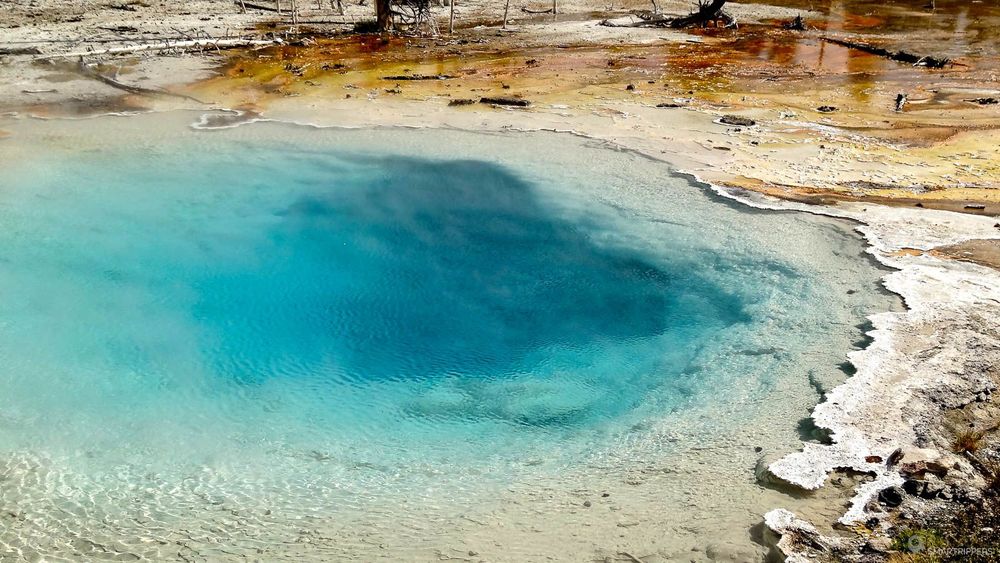
Then the pontoons take us to the edge of the big bubbling pond of Fountain Paint Pot, which gave its name to the area. The mud puddle with its grey, beige and pink hues gives the impression of a giant pot whose contents would have been brought to a small boil. Under the effect of the underground heat, the liquid forms beautiful bubbles that burst at the surface, some of which project mud far enough away on the edges of the broth.
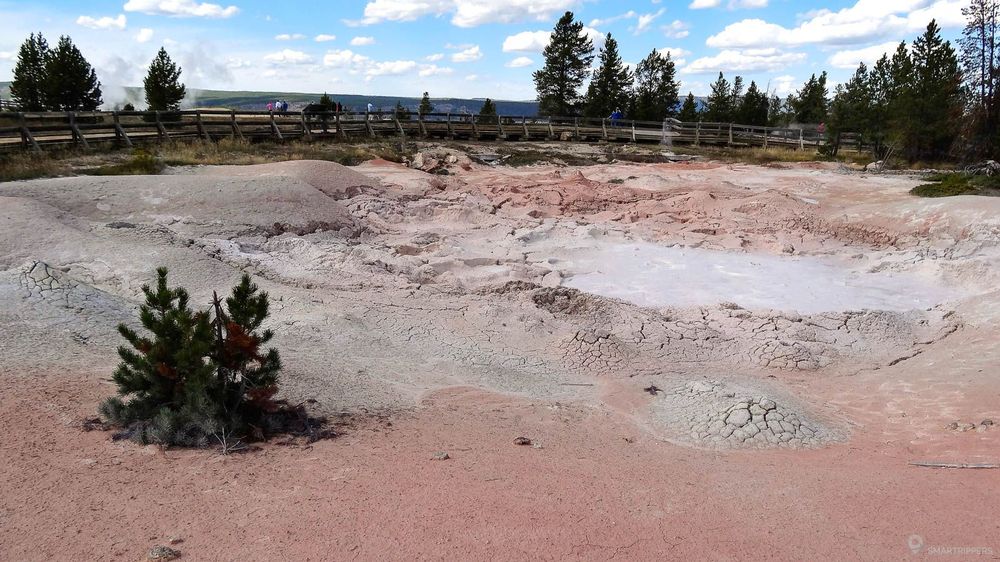
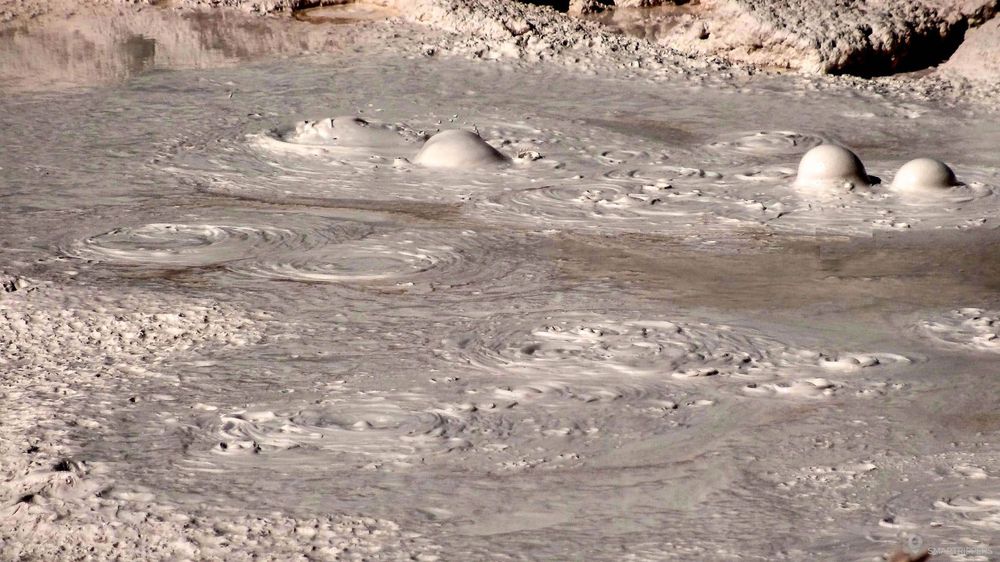
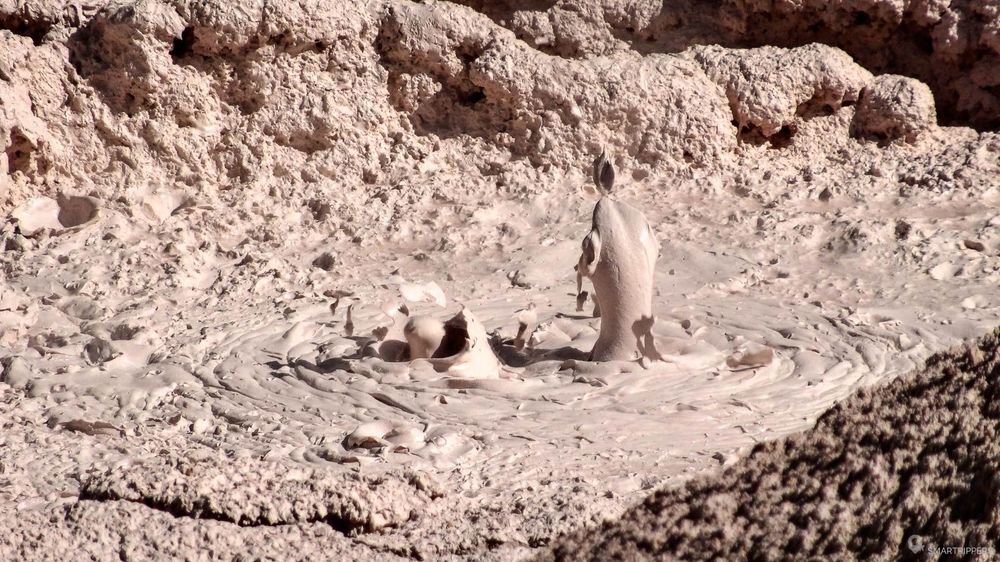
A little further on, we will notice Red Spouter, composed of two cavities that can gather to form a large pond if it rained recently. As with sludge ponds, its activity will depend on the water content of the soil. If the soil is wet, the cavities will be filled with boiling reddish water. If the ground is dry, Red Spouter will turn into one or two whistling chimneys, ejecting a loud stream of noisy steam. If you are lucky, you will be able to see both phenomena at the same time, as the second cavity tends to dry faster than the first, as we did during our visit in mid-September.
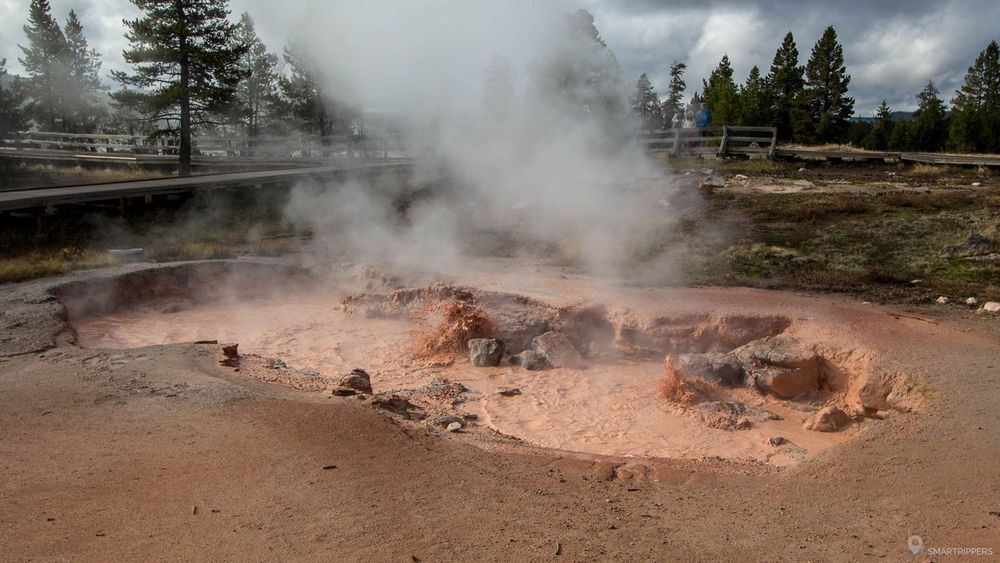
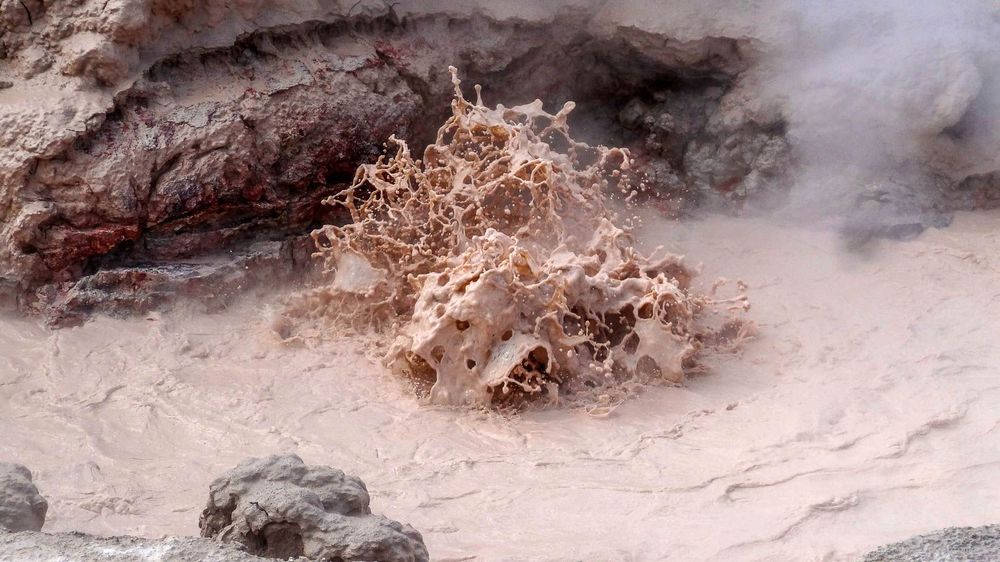
Discovering Dry Red Spouter is really impressive! If you are lucky, you will hear a screaming whistle coming out of the bowels of the earth and throwing out a beautiful stream of steam!
Continuing the loop leads to a small group of active geysers. The first, Jet Geyser, very frequently erupts every 7 to 30 minutes, but each time it seemed to us to see eruptions much closer together, sometimes every 2 to 5 minutes. For 1 minute, he projects at a steady and fast rate a small jet of water up to 6 meters high.
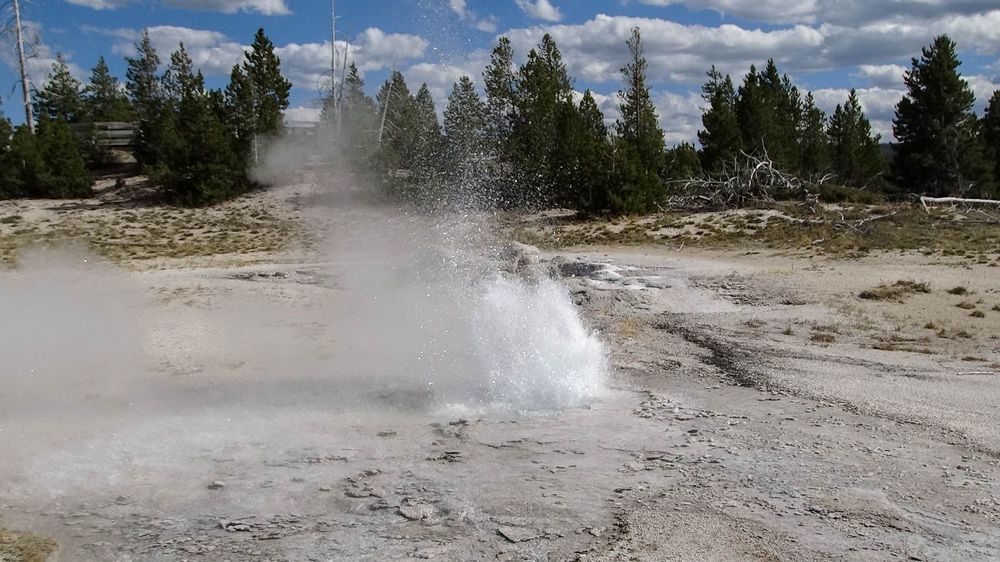
Watch out for the wind, which can knock the steam down on the pontoons and make them wet.
On the other side, Clepsydra Geyser is just as active by propelling more impressive water jets up to 14 metres. Behind Clepsydra Geyser, another small geyser appears to be on the same cavity system and causes small jets to erupt in the background. In front of Clepsydra Geyser, Spasm Geyser is calmer but wakes up regularly to expel small jets (although we have never seen him before).

Finally, for the calmer ones, Morning Geyser once caused eruptions of about 30 minutes and up to 61 meters high! But he seems to have fallen asleep since October 2013. As for its neighbour, Fountain Geyser, it is still active and periodically erupts every 6 to 12 hours for 30 minutes, with a jet of up to 24 metres high.
The loop ends then by returning to the car park which is equipped with toilets.
Summary
Fountain Paint Pot is an active area, located in Yellowstone, in Lower Geyser Basin. The area is famous for its bubbling mud ponds, whistling fumes and active geysers. Fountain Paint Pot is discovered thanks to a loop of 1 km partly on pontoons, which makes it possible to go around and get close to the various phenomena.
The way begins with two beautiful blue hot springs, Celestine Pool and Silex Spring. Their blue color indicates that the spring rises above 100 degrees in the centre, while the water is colder on the sides attracting bacteria that dye the edges of yellow and ochre.

Then the pontoons take us to the edge of the big bubbling pond of Fountain Paint Pot, which gave its name to the area. The mud puddle with its grey, beige and pink hues gives the impression of a giant pot whose contents would have been brought to a small boil. Under the effect of the underground heat, the liquid forms beautiful bubbles that burst at the surface, some of which project mud far enough away on the edges of the broth.



A little further on, we will notice Red Spouter, composed of two cavities that can gather to form a large pond if it rained recently. As with sludge ponds, its activity will depend on the water content of the soil. If the soil is wet, the cavities will be filled with boiling reddish water. If the ground is dry, Red Spouter will turn into one or two whistling chimneys, ejecting a loud stream of noisy steam. If you are lucky, you will be able to see both phenomena at the same time, as the second cavity tends to dry faster than the first, as we did during our visit in mid-September.


Discovering Dry Red Spouter is really impressive! If you are lucky, you will hear a screaming whistle coming out of the bowels of the earth and throwing out a beautiful stream of steam!
Continuing the loop leads to a small group of active geysers. The first, Jet Geyser, very frequently erupts every 7 to 30 minutes, but each time it seemed to us to see eruptions much closer together, sometimes every 2 to 5 minutes. For 1 minute, he projects at a steady and fast rate a small jet of water up to 6 meters high.

Watch out for the wind, which can knock the steam down on the pontoons and make them wet.
On the other side, Clepsydra Geyser is just as active by propelling more impressive water jets up to 14 metres. Behind Clepsydra Geyser, another small geyser appears to be on the same cavity system and causes small jets to erupt in the background. In front of Clepsydra Geyser, Spasm Geyser is calmer but wakes up regularly to expel small jets (although we have never seen him before).

Finally, for the calmer ones, Morning Geyser once caused eruptions of about 30 minutes and up to 61 meters high! But he seems to have fallen asleep since October 2013. As for its neighbour, Fountain Geyser, it is still active and periodically erupts every 6 to 12 hours for 30 minutes, with a jet of up to 24 metres high.
The loop ends then by returning to the car park which is equipped with toilets.
The strong activity of geysers almost continues for some of them.
Mud pots and strident vapour jets.
The parking lot is quickly full in summer.
We are Sandrine and Flo, French thirty-somethings. In 2019 we quit everything to live our dream, become nomads and travel around the world. We left with our baby, Lena, who was only 5 months old at the time. After a first trip around the Pacific Ocean by plane and a long 3 months stay in Hawaii, we left to discover Iceland for 3 months on board our 4WD pickup truck and truck camper. Then we continued our adventure in North America.
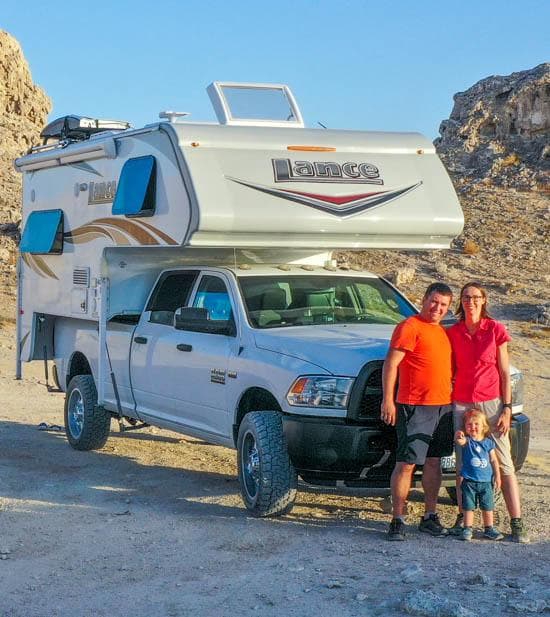
Today, if we can continue this adventure, it is above all thanks to our blog, Smartrippers! We created it one day in 2016, with the desire to share our good travel tips, without thinking that it would lead us there! We have developed it a lot over the years and have become experts on our 3 favorite destinations: Hawaii, Iceland and the American West. We now guide you to these destinations to help you plan the trip of your dreams!
Follow our adventures!